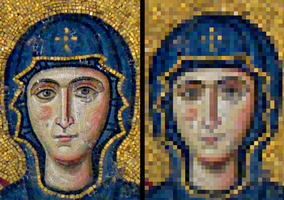SOURCE: Orthodox Arts Journal
Editor’s note: This post is the first of a series on this topic from Fr. Silouan
I do not venerate matter, I venerate the fashioner of matter, who became matter for my sake and accepted to dwell in matter and through matter worked my salvation, and I will not cease from reverencing matter, through which my salvation was worked.
St. John of Damascus, On the Divine Images, I: 16
There are also celestial bodies and terrestrial bodies; but the glory of the celestial is one, and the glory of the terrestrial is another. There is one glory of the sun, another glory of the moon, and another glory of the stars; for one star differs from another star in glory.
I Cor. 15: 40-41
And I reverence… all matter participating in divine energy and serving my salvation, and I venerate [it] because of the divine energy.
St. John of Damascus, III:34
Mechanically reproduced icons are inherently ambiguous. They share certain features with the original icon but are also radically different from it. The slippery, neither here-nor-there status of these mechanical reproductions makes them hard to grasp conceptually. This makes the task of trying to clarify their role in liturgical aesthetic experience problematic, if not treacherous. They are at once real and somehow less than real icons. In focusing on the real side, we minimize the problems they introduce in the life of the Church, but in pointing out the less than real side we run the danger of overstating the case and fueling formalist ideology. In any case, the risk must be taken. Accessible and inexpensive reproductions of icons have helped the revival of icon painting. They are here to stay. Nevertheless, they raise theological questions regarding how materials and craftsmanship affect the icon’s multi-layered aesthetic and liturgical function.
During the Iconoclastic debates, it was taken for granted that an icon was a work of craftsmanship, fashioned by human hands and skill. In the midst of doctrinal controversy over the nature or validity of images of Christ and the saints, there seemed to be no need to dwell too much on the icon’s manufacture. It was enough to know that an icon was, as St. Theodore the Studite says, “perhaps of wood, or paint, or gold, or silver, or some of the various materials … .”[1] As Moshe Barasch points out:
“It was only the completed picture, the finished work of art that was considered in the Iconoclastic debates. This feature stands out with particular clarity when we compare iconoclastic literature with the more or less practical art theory of the same period and culture. For the painter in the workshop, and the critic who wishes to influence the outcome of his efforts, that stage preceding the finished work, that is, the process of shaping the icon, is of course of central significance. No wonder that, in one form or another, questions pertaining to the stage emerge in regular art literature. But in the literature originating in the Iconoclastic debates, references to that stage are virtually absent. We hear close to nothing about the artist, nor is there any consideration of how the icon (that very icon that is so violently attacked or so enthusiastically defended) comes into being. All that is sometimes said is that the icon is ‘made by hands,’ or, rather rarely, that it has descended miraculously from heaven. So far removed is that literature from the real artist that authors do not even make demands on his behavior.”[2]
Though related, there is a difference due to their respective historical moments in the way the Fathers took for granted and we tend to ignore how the icon comes into being, or the process of shaping the icon. Considering the icon as a completed picture or a finished work of art was only natural in a society where it was a given that most things were not the result of mass production by machines, but the fruit of long arduous effort in the workshop of a painter, mosaicist, carver, silversmith, weaver, etc.[3] Now, however, the advent of the age of mechanical reproduction has brought us to a position where the craftsmanship of the icon can no longer be taken for granted. In a society such as ours that is constantly immersed in images, the importance of the artistic and material side of the icon tends to be ignored and even undermined. We usually relate to an image mainly as a representation having an existence independent of the material medium through which we perceive it. The icon then becomes another image among thousands. It lacks any need of proper embodiment, a situation that erodes our awareness of it as a sacred object. Consequently, it has now become necessary to consider the implications of this situation and to underline the importance of using real, hand-made icons in the context of Orthodox worship.
This article examines how mechanical reproductions lessen the icon’s “iconicity,” that is, its liturgical efficacy, full iconic potential, and symbolic power. It aims to clarify how the role of materials and craftsmanship affect the function of the icon as a concrete object within the aesthetic experience of liturgy. As will be demonstrated, these can either hamper or aid our “uplifting” in the course of worship. In other words, this article will approach the icon in its ontological status as a painting or work of art and not solely as a picture or “image” in the abstract. It is a liturgical object having inherent properties that make it what it is. First, let us look at what duplicates have to offer.
Disappointing Duplicates
 The effects of digital reproduction
The effects of digital reproduction
We betray our dissatisfaction by creating mock antiques, attempting to make reproductions look “more real.” We mount them on wood, add red borders, and apply cracked varnish with distressed gilding to conjure an ancient icon. Tempera layering is duplicated with silk-screening and mural reproductions are applied like wallpaper for those wanting instant “frescoes.” These are fast and cheap solutions that seek to satiate consumer demand for holy images. Quality is sacrificed for quantity and affordability. While we might try to suspend our disbelief, we cannot escape our awareness that such images remain unconvincing shadows of the original, that we encounter a kind of ruse. Such “icons” become yet another symptom of the hegemony of appearances in our age.[7]
Image Sensory Overload
 Sensory overload is today's status quo
Sensory overload is today's status quo
“Our age chiefly dreams up and manufactures simulacra. Shopping malls are adorned with plants and trees that look real but aren’t. Television and movie studios present us with times, places and environments that don’t exist. Advertisements refer us to worlds that have no connection with reality. Men and women are painted and dyed, fakes and shams, copies of which no original has ever existed, not a few of them surgically altered to show the world faces which aren’t true, ages which deceive… The extravagant (and extravagantly wasteful) hegemony of appearances has destroyed the essence and distinctive presence of that which is.”[11]
Surrounded by surrogates, detached from nature and organic life, and immersed in techno-dystopia, we fail to see the Uncreated, the truly Real, in the beauty of creation. All becomes disembodied, flat, cold, mechanized, lifeless repetition, and uniformity. The authenticity and warmth of the one-of-a-kind and humanly crafted object becomes a blurry memory, a thing of the past. We forget how this craftsmanship expresses the image of God in man and emulates the divine Craftsman in His fashioning of an infinite variety of unique life forms. Desensitized by mass production, we no longer discern the subtle effects of unique properties of materials and textures. It becomes very difficult to distinguish diamonds from rhinestones.
[1] St. Theodore the Studite, On the Holy Icons, First Refutation of Iconoclasm, translated by Catharine P. Roth, SVS Press, Crestwood, N.Y., 1981, p.32.
[2] M. Barasch, Icon: Studies in the History of an Idea, New York University, New York, 1995, p.6.
[3] W. Benjamin, Illuminations: Essays and Reflections, Schocken Books, New York, 1968, pp.217-252. “In principle a work of art has always been reproducible. Men could always imitate man made artifacts. Replicas were made by pupils in practice of their craft, by masters for diffusing their works, and, finally, by third parties in the pursuit of gain. Mechanical reproduction of a work of art, however, represents something new. Historically, it advanced intermittently and in leaps at long intervals, but with accelerated intensity. Greeks knew only two procedures of technically reproducing works of art: founding and stamping. Bronzes, terra cottas, and coins were the only art works which they could produce in quantity. All others were unique and could not be mechanically reproduced. With the woodcut graphic art became mechanically reproducible for the first time, long before script became reproducible in print. The enormous changes which printing, the mechanical reproduction of writing, has brought about in literature are a familiar story. However, within the phenomenon which we are here examining from the perspective of world history, print is merely a special, though particularly important, case. During the Middle Ages engraving and etching were added to the woodcut; at the beginning of the nineteenth century lithography made its appearance.” W. Benjamin,Ibid., pp.220-21.
[4] See M. Lowell, “MUCH Cheaper Than Real”: Confronting the New Iconoclasm,Hexaemeron.org, April 9, 2012, http://hexaemeron.wordpress.com/2012/04/09/much-cheaper-than-real-2/.
[5] Walter Benjamin notes, “The situations into which the product of mechanical reproduction can be brought may not touch the actual work of art, yet the quality of its presence is always depreciated. (…) One might subsume the eliminated element in the term “aura” and go on to say: that which withers in the age of mechanical reproduction is the aura of the work of art. This is a symptomatic process whose significance points beyond the realm of art. One might generalize by saying: the technique of reproduction detaches the produced object from the domain of tradition.” W. Benjamin,op. cit., p.232. See the section below, “Uplifting Materiality and Symbol”, in which the idea of the “glory” of “bodies” is discussed. This, I believe, parallels Benjamin’s idea of “aura” even though it is not intended to have the occult overtones that his term conjures. W. Benjamin, Ibid., p.223.
[6] The observations that will be outlined here parallel Walter Benjamin’s, who says, “One might generalize by saying: the technique of reproduction detaches the object from the domain of tradition. By making many reproductions it substitutes a plurality of copies for a unique existence. And in permitting the reproduction to meet the beholder or listener in his own particular situation, it reactivates the object reproduced. These two processes lead to a tremendous shattering of tradition … .” Ibid., p.223. He looks at the problem of mechanical reproductions as the “detaching of the object from the domain of tradition.” Ibid. In other words, removing the object of religious devotion from its formerly static cult context is a movement from the sacred to the profane. As will be explained, in the case of icon reproductions, the reverse also happens. They bring elements of the profane into sacred space. Through the reproduction, there is also, as Benjamin notes, a “reactivation” of the original from its cult context into multiple places. This constant “reactivation” process, as we will see, degrades iconicity, as when an image loses definition when repeatedly passed through a copy machine. In the end there is no question that a “tremendous shattering of tradition” takes place. Ibid.
[7] See f.11 below.
[8] See the documentary The Icon, Episode One, Holy Images, http://ikona.eparhijaniska.rs/ep_1_srb.html.
[9] See G. Debord, The Society of the Spectacle, Black & Red, Detroit, Michigan, June 1, 2000.
[10] J. Berger, Ways of Seeing, Penguin Books, London, 1972, pp.32–34.
[11] A privately translated version of a writing by Metropolitan Nicholas (Hatzinikolas) of Mesogaias,Anthropos Metheoros, Athens, 2005, the source of which is unverifiable by this author.
